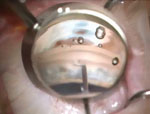  |
When it comes to the treatment and management of glaucoma, one of today’s hottest topics is minimally invasive glaucoma surgeries, or MIGS. MIGS procedures have been gaining momentum and are being adopted by surgeons in the United States and worldwide due to their efficacy and safety profile. Traditional glaucoma filtration surgeries have been limited, consisting of either a trabeculectomy or drainage implant. Although these traditional procedures can lower pressures to the single digits, they come with complications, including scar formation, bleb leaks, hypotony, choroidal hemorrhage, infection and cataract formation.
With the introduction of MIGS, eye care providers can offer patients an alternative glaucoma procedure to control and treat their glaucoma with less risk of complications. These procedures are indicated for mild to moderate open-angle glaucoma and are used in conjunction with cataract surgery, unlike canaloplasty and the Trabectome, which are performed as a single surgery.
 | |
| Using a gonioprism, the iStent is secured into Schlemm’s canal. |
MIGS
In previous columns, we introduced several early MIGS procedures. The first player in the market was the canaloplasty (Ellex) procedure (www.reviewofoptometry.com/content/c/33594/), followed by the Trabectome (Neomedix) (www.reviewofoptometry.com/content/c/35213/) and later the iStent (Glaukos) (www.reviewofoptometry.com/content/c/45133/). These procedures have been adopted by both glaucoma specialists and cataract surgeons alike due to their numerous benefits. Nonetheless, MIGS do have some disadvantages (see “MIGS Pros and Cons.”)
Comanagement
As comanaging optometrists, it is important to have a strong understanding of these procedures and the benefits they have over traditional glaucoma treatments and cataract surgery alone. About 19% of patients undergoing cataract surgery have a concurrent diagnosis of glaucoma.1 Although patients may seem to be adequately treated with glaucoma medications, patient compliance and IOP control are not always guaranteed. Researchers have found that compliance increases with decreased dosage regimen and complexity.2 Patients who are prescribed a once-daily medication show 79% compliance vs. 51% for QID regimens.2 MIGS help address these concerns, in addition to improving vision and quality of life for patients with cataracts and glaucoma.
MIGS Pros and Cons1,2
Drawbacks:
1. iStent. Connecting patients to the promise of micro invasive glaucoma surgery. www.glaukos.com/istent/. |
Over the next few columns, we will address several newer MIGS procedures currently available or under clinical investigation, including: the Hydrus Microstent (Ivantis), CyPass Micro-Stent (Transcend Medical), Xen Gel Stent (AqueSys), Solx Gold Shunt (Solx) and the ICE procedure (iStent + cataract surgery + endoscopic cyclophotocoagulation). Stay tuned to learn more about these exciting MIGS procedures.
1. Tseng VL, Yu F, Lum F, et al. Risk of fractures following cataract surgery in Medicare beneficiaries. JAMA. 2012;308(5):493-501.2. Claxton AJ, Cramer J, Pierce C. A systematic review of the Associations between dose regimens and medication compliance. Clinical Therapeutics. 2001;23(8).

